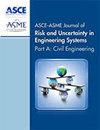A Structural Equation Model to Analyze the Effects of COVID-19 Pandemic Risks on Project Success: Contractors’ Perspectives
IF 2.7
3区 工程技术
Q2 ENGINEERING, CIVIL
Asce-Asme Journal of Risk and Uncertainty in Engineering Systems Part A-Civil Engineering
Pub Date : 2023-09-01
DOI:10.1061/ajrua6.rueng-1008
引用次数: 0
Abstract
The purpose of this paper is to capture the direct and indirect effects of COVID-19 emerging risks on construction projects' success in developing countries from the contractors' perspective. To achieve this, we collected data from Iraqi construction industry and conducted the following multistage research methodology: (1) preliminary investigation with four construction contractors to identify the success indicators of construction projects;(2) focus group session with 11 experts to identify the COVID-19 emerging risks for the construction industry;(3) semistructured interviews with seven construction experts to develop several hypotheses on the effect of COVID-19 emerging risks on project success;(4) survey data collection from 99 construction contractors;and (5) development of a structural equation model (SEM) to analyze the effects of COVID-19 emerging risks on project success. The results of the SEM analysis show that financial market (FM)-related risks, supply chain operations (SCO)-related risks, health and safety of construction workforce (HSCW)-related risks, organizational implications (OI)-related risks, and contractual implications (CI)-related risks have a significant impact on construction projects success. CI-related risks have the strongest total effects on project success, followed by OI-related risks, FM-related risks, HSCW-related risks, and SCO-related risks, respectively. The results also emphasis the significant mediation role of CI between COVID-19 emerging risks and project success. This study contributes to the body of knowledge and contracting companies by helping researchers and construction contractors to better understand how the key risk factors emerging from extreme conditions like the COVID-19 pandemic affect construction projects' success and may serve as a guideline for developing effective response strategies. © 2023 American Society of Civil Engineers.基于结构方程模型分析COVID-19大流行风险对项目成功的影响:承包商视角
本文的目的是从承包商的角度捕捉新冠肺炎风险对发展中国家建设项目成功的直接和间接影响。为此,我们收集了伊拉克建筑行业的数据,并采用了以下多阶段研究方法:(1)与4家建筑承包商进行初步调查,确定建筑项目的成功指标;(2)与11位专家进行焦点小组讨论,确定建筑行业的新冠肺炎风险;(3)与7位建筑专家进行半结构化访谈,提出新冠肺炎风险对项目成功影响的若干假设;(4)收集99家建筑承包商的调查数据;(5)建立结构方程模型(SEM)分析COVID-19新出现的风险对项目成功的影响。SEM分析的结果表明,金融市场(FM)相关风险、供应链运营(SCO)相关风险、建筑劳动力健康与安全(HSCW)相关风险、组织影响(OI)相关风险和合同影响(CI)相关风险对建筑项目的成功有显著影响。与ci相关的风险对项目成功的总体影响最大,其次是与oi相关的风险、与fm相关的风险、与hscw相关的风险和与sco相关的风险。结果还强调了CI在COVID-19新兴风险与项目成功之间的显著中介作用。本研究通过帮助研究人员和建筑承包商更好地了解COVID-19大流行等极端条件下出现的关键风险因素如何影响建筑项目的成功,为知识体系和承包公司做出了贡献,并可能为制定有效的应对策略提供指导。©2023美国土木工程师学会。
本文章由计算机程序翻译,如有差异,请以英文原文为准。
求助全文
约1分钟内获得全文
求助全文
来源期刊

Asce-Asme Journal of Risk and Uncertainty in Engineering Systems Part A-Civil Engineering
Engineering-Building and Construction
CiteScore
5.30
自引率
8.00%
发文量
86
期刊介绍:
The journal will meet the needs of the researchers and engineers to address risk, disaster and failure-related challenges due to many sources and types of uncertainty in planning, design, analysis, construction, manufacturing, operation, utilization, and life-cycle management of existing and new engineering systems. Challenges abound due to increasing complexity of engineering systems, new materials and concepts, and emerging hazards (both natural and human caused). The journal will serve as a medium for dissemination of research findings, best practices and concerns, and for the discussion and debate on risk and uncertainty related issues. The journal will report on the full range of risk and uncertainty analysis state-of-the-art and state-of-the-practice relating to civil and mechanical engineering including but not limited to:
• Risk quantification based on hazard identification,
• Scenario development and rate quantification,
• Consequence assessment,
• Valuations, perception, and communication,
• Risk-informed decision making,
• Uncertainty analysis and modeling,
• Other related areas.
Part A of the journal, published by the American Society of Civil Engineers, will focus on the civil engineering aspects of these topics. Part B will be published by the American Society of Mechanical Engineers focusing on mechanical engineering.
 求助内容:
求助内容: 应助结果提醒方式:
应助结果提醒方式:


